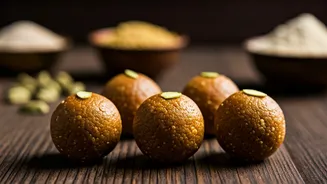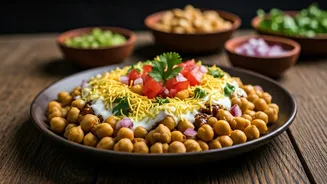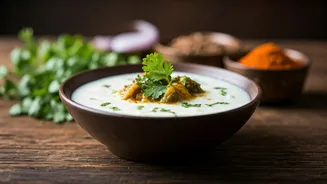Ladoo's Timeless Allure
Besan Ladoo, a cherished Indian sweet, holds a special place in the hearts of many. The simplicity of its ingredients belies the rich and complex flavors
it offers. The history of Besan Ladoo is intertwined with Indian culture. It is a traditional treat often prepared for festivals and celebrations, symbolizing joy, prosperity, and togetherness. The delightful blend of gram flour, ghee, and sugar creates a symphony of textures and tastes that are both comforting and satisfying. Each bite of a well-made Besan Ladoo is a reminder of tradition and the warmth of shared moments.
Gathering Essential Ingredients
Creating perfect Besan Ladoo begins with sourcing the right ingredients. Gram flour (besan) is the star, lending its characteristic nutty flavor. High-quality ghee is crucial for richness and a beautiful aroma. Sugar adds the necessary sweetness. Cardamom powder infuses a delicate fragrance. Additionally, a handful of chopped nuts, such as almonds or cashews, can add a delightful crunch. Ensure the besan is fresh and fine. Ghee should be pure for the best taste. The quality of each ingredient directly impacts the final product. Careful selection paves the way for ladoos that are irresistibly delicious and visually appealing, promising a truly authentic experience.
Roasting Besan's Flavor
The process of roasting the besan is essential. Begin by gently heating the ghee in a pan. Once the ghee is melted, add the gram flour. The mixture must be stirred continuously over low to medium heat. This prevents burning and ensures even roasting. The besan will gradually release its aroma, and the color will deepen to a golden brown. This indicates that the flour is properly roasted, which is vital for the final flavor and texture. Patience is key, as this process can take some time. The aroma that fills the kitchen during this stage is one of the most rewarding aspects. This is where the flavor profile of the ladoos begins to truly develop.
Forming the Sweet Spheres
Once the besan has cooled slightly, incorporate the sugar and cardamom powder. Mix thoroughly to evenly distribute the sweetness and spice. If using nuts, add them at this point. The mixture should be warm enough to handle but not too hot. Take small portions of the mixture and gently shape them into round balls. The size can be adjusted to personal preference. Consistency is key; ensure each ladoo is firmly packed so they retain their shape. If the mixture feels too dry, add a little extra melted ghee. Assembling the ladoos is a labor of love. Each round treat embodies tradition.
Troubleshooting & Tips
Perfecting Besan Ladoo involves addressing common challenges. If the mixture is dry, add a little more ghee. If it is too oily, roast the besan for a longer duration. The final texture should be slightly soft and crumbly. The key is patience and attention to detail. Storing the ladoos properly is crucial to maintaining their freshness. Store them in an airtight container at room temperature for up to a week. For a longer shelf life, they can be refrigerated, though their texture might change slightly. Freshly made ladoos offer the best taste experience. Experimenting with different nuts and flavors can also enhance the ladoos to match preferences.
Cultural Significance & Variations
Besan Ladoo is more than just a dessert; it is a symbol of celebration and auspiciousness in Indian culture. It often features in festivals, weddings, and religious ceremonies. The act of making and sharing ladoos represents community and shared joy. Several variations of the recipe exist, catering to diverse tastes. Some add saffron for color and flavor. Others incorporate different types of nuts. There are also regional variations, with different spices and techniques. Each variation adds a unique dimension to the classic recipe. Besan Ladoo remains a versatile and beloved treat, cherished across generations.



